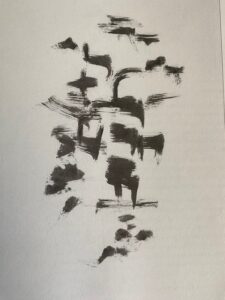 ‘The artist should preach nothing – not even their own autonomy. Their art should speak its own truth, and in so doing will be in harmony with every other kind of truth – moral, metaphysical and mystical.’
‘The artist should preach nothing – not even their own autonomy. Their art should speak its own truth, and in so doing will be in harmony with every other kind of truth – moral, metaphysical and mystical.’
Thomas Merton was a writer, poet, photographer, spiritual director and monk, but as artist he has been largely ignored. There are, however, over nine hundred original drawings and calligraphies in the collection at The Thomas Merton Center at Bellarmine University. Roger Lipsey in his book ‘Angelic Mistakes’ looks at some of Merton’s art work from the 1960s. In his foreword to the book, Paul Pearson, the director of the Merton Center, reminds us that Merton’s parents were artists, and that in his childhood – especially after the death of his mother, the boy would have been in the company of other artists known to his father Owen. About his father’s paintings, Merton wrote:
‘His vision of the world was sane, full of balance, full of veneration for structure, for the relations of masses and for the circumstances that impress an individual’s identity on each created thing.’
For Merton his journey as artist moved from childhood drawings, to cartoons whilst a student (sometimes sexy, sometimes funny, sometimes political), from there to simple religious images when Merton first became a monk, and, then, later, Zen calligraphy and images – visual art that Pearson describes as question marks expressing Merton’s mature relationship with God, the world and self.
Initially ambivalent about his visual art in the sense of how it might connect with the values and traditions of the Catholic church, Merton found that trying, at he put it, his hand at ‘some abstract-looking art’ at a time of inner turmoil, had impressed him with its expressive potential, and its possible value as part of his religious search.
The Zen calligraphy art from the last eight years of Merton’s life, 1960-1968, Merton describes in his notes on the drawings, as:
‘… simple signs and ciphers of energy, acts or movements intended to be propitious. Their “meaning” is not to be sought on the level of convention or of concept … They came to life when they did, in the form of reconciliations as expressions of unique and unconscious harmonies appropriate to their own moment though not confined to it.’
Merton writes that in a world cluttered with signs and digits all to do with business, law, government and war, making such a nondescript mark is part of a vocation to be outside, and to ‘remain firmly alien.’ It is part of a vocation to ‘be inconsequent’.
He sees the work then as:
‘…decidedly hopeful in their own way in so far as they stand outside all processes of production, marketing, consumption and destruction … Ciphers, signs without prearrangement, figures of reconciliation, notes of harmony … Summonses to awareness, but not to awareness of … no need to categorize.’
For Merton the only dream for the artist is when they take a brush in their hand and dip it into ink, ‘is to reveal a new sign that can continue to stand by itself and to exist in its own right, transcending all logical interpretations.’